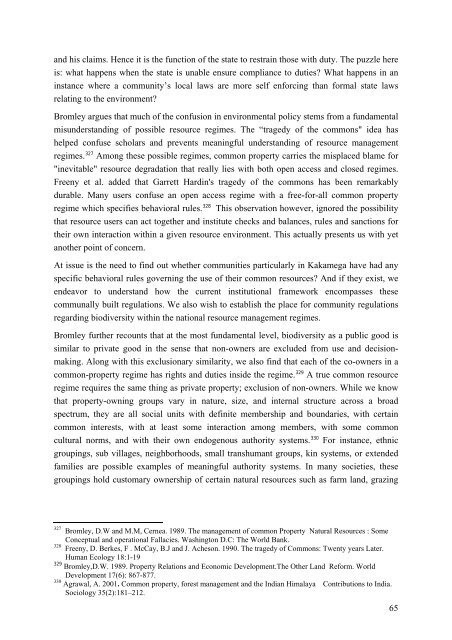THE UNIVERSITY OF LEIPZIG
THE UNIVERSITY OF LEIPZIG
THE UNIVERSITY OF LEIPZIG
You also want an ePaper? Increase the reach of your titles
YUMPU automatically turns print PDFs into web optimized ePapers that Google loves.
and his claims. Hence it is the function of the state to restrain those with duty. The puzzle here<br />
is: what happens when the state is unable ensure compliance to duties? What happens in an<br />
instance where a community’s local laws are more self enforcing than formal state laws<br />
relating to the environment?<br />
Bromley argues that much of the confusion in environmental policy stems from a fundamental<br />
misunderstanding of possible resource regimes. The “tragedy of the commons" idea has<br />
helped confuse scholars and prevents meaningful understanding of resource management<br />
regimes. 327 Among these possible regimes, common property carries the misplaced blame for<br />
"inevitable" resource degradation that really lies with both open access and closed regimes.<br />
Freeny et al. added that Garrett Hardin's tragedy of the commons has been remarkably<br />
durable. Many users confuse an open access regime with a free-for-all common property<br />
regime which specifies behavioral rules. 328 This observation however, ignored the possibility<br />
that resource users can act together and institute checks and balances, rules and sanctions for<br />
their own interaction within a given resource environment. This actually presents us with yet<br />
another point of concern.<br />
At issue is the need to find out whether communities particularly in Kakamega have had any<br />
specific behavioral rules governing the use of their common resources? And if they exist, we<br />
endeavor to understand how the current institutional framework encompasses these<br />
communally built regulations. We also wish to establish the place for community regulations<br />
regarding biodiversity within the national resource management regimes.<br />
Bromley further recounts that at the most fundamental level, biodiversity as a public good is<br />
similar to private good in the sense that non-owners are excluded from use and decision-<br />
making. Along with this exclusionary similarity, we also find that each of the co-owners in a<br />
common-property regime has rights and duties inside the regime. 329 A true common resource<br />
regime requires the same thing as private property; exclusion of non-owners. While we know<br />
that property-owning groups vary in nature, size, and internal structure across a broad<br />
spectrum, they are all social units with definite membership and boundaries, with certain<br />
common interests, with at least some interaction among members, with some common<br />
cultural norms, and with their own endogenous authority systems. 330 For instance, ethnic<br />
groupings, sub villages, neighborhoods, small transhumant groups, kin systems, or extended<br />
families are possible examples of meaningful authority systems. In many societies, these<br />
groupings hold customary ownership of certain natural resources such as farm land, grazing<br />
327<br />
Bromley, D.W and M.M, Cernea. 1989. The management of common Property Natural Resources : Some<br />
Conceptual and operational Fallacies. Washington D.C: The World Bank.<br />
328<br />
Freeny, D. Berkes, F . McCay, B.J and J. Acheson. 1990. The tragedy of Commons: Twenty years Later.<br />
Human Ecology 18:1-19<br />
329<br />
Bromley,D.W. 1989. Property Relations and Economic Development.The Other Land Reform. World<br />
Development 17(6): 867-877.<br />
330<br />
Agrawal, A. 2001. Common property, forest management and the Indian Himalaya Contributions to India.<br />
Sociology 35(2):181–212.<br />
65






